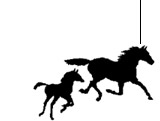|
Horse Slaughter for Human Consumption
What is the state of horse slaughter in Canada?
One of the most baffling issues surrounding the equine world, and one that many Canadians may still be unaware of, is the continual slaughter of our nation's horses.
Why does this industry exist?
Horse slaughter in Canada exists for one reason and one reason onlyfor the sole purpose of providing horse meat for foreign markets. Europeans and Asians who consume horse flesh consider it a delicacy and are willing to pay a high price for it. It is not a means of euthanasia; this country is not over-populated with horses.
Where do the horses that are slaughtered come from?
Horses are not raised for slaughter as they are not traditional food animals, so they are either bought at auction or stolen, although some people actually take them directly to the plants themslves. Many of them are spent mares and foals that are "byproducts" of the Pregnant Mare Urine (PMU) or Premarin© industry, now more than ever with its recent downsizing because of the sharp fall in the market for these drugs.
Numerous licensed horse dealers, known as "killer buyers" who act as middlemen for the slaughterhouses frequent these auctions. Mass quantities of horses are sold to these dealers at unbelievably cheap prices, who then transport the horses inhumanely and resell them to the slaughterhouses for profit. Many times an auction house and the dealer will not turn away an unfit animal, because as long as it can live till it gets to slaughter, it can be sold for meat.
How are the horses actually slaughtered?
Horses are often transported for more than 24 hours without rest, water, or food, while unprotected from weather extremes in thin metal-walled trailers. Sick and/or injured horses frequently are forced onto double-deck trailers that were designed for short-necked animals including cattle and sheep. They are often injured and some are already dead by the time they reach their destination.
Once at the slaughterhouse, the suffering and abuse continue unabated. Often, horses are left on the tightly packed double-deck trailers for long periods of time while a few are forcibly moved off. They are then held in muck infested pens until it is their turn to be butchered.
The horses stand in the killing line smelling the blood, sensing the terror. They are electrocuted or speared into the "kill box" where they shake violently, falling, unable to stand from fear. Callous workers, using long, thick fiberglass rods, poke and beat the horses' faces, necks, backs, and legs as they are shoved through the facility into the kill box.
They are then bludgeoned in the head, often repeatedly, with the "captive dead-bolt" gun which drives a four-inch spike into their skull, in order to stun them for the "process," but is not intended to kill them, Horses writhe in the holding stall (known as the "kill box"), legs buckling under their weight after each traumatic, misguided and ineffective blow to their heads. Death is not swift for these terrified and noble animals. (Note: It has been reported that a bullet to the head using a .22 is occurring at some Canadian horse slaughter plants.)
Once down, the horses are caught by the hind leg and hoisted into the air, where they are dangled down a line to an individual who slits their throat, and begins the dismemberment process.
Quote from a slaughterhouse worker:
"You move so fast, you don't have time to wait till a horse bleeds out. You skin him as he bleeds. Sometimes a horse's nose is down in the blood, blowing bubbles, and he suffocates."
Below are links to pdf graphic images of horse slaughter:
Image 1
Image 2
Image 3
You can make a difference by getting involved in the passing of legislation to ban this industry.
"Help us lead Canada's horses away from barbarism . .
and into the protected pastures of a civilized
nation."
|


